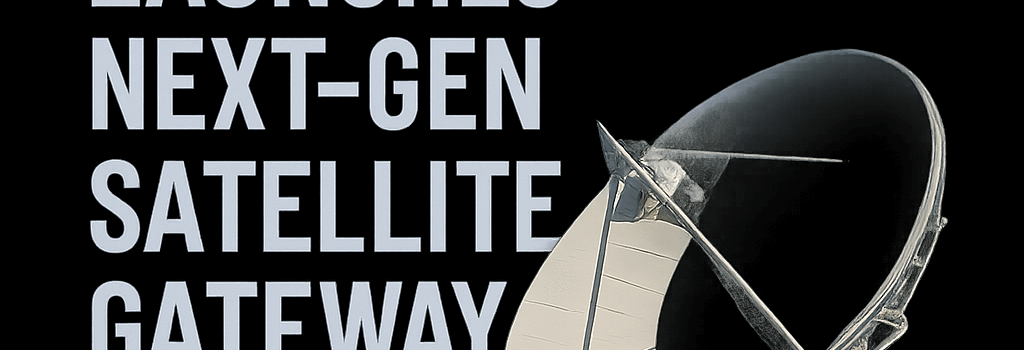Northwood Space Launches Next-Gen Satellite Gateway

Introduction
In a milestone test this July, Northwood Space successfully demonstrated its second-generation Portal phased array antenna, designed to simultaneously track and communicate with satellites across low-Earth orbit (LEO), medium-Earth orbit (MEO), and geostationary orbit (GEO). This achievement ushers in a new era of high-throughput, fully software-defined ground stations optimized for the data-driven demands of modern spacecraft.
“This system will be the first building block in our network that over the next three years aims to support 500 simultaneous spacecraft across multiple frequencies, data rates, and orbits,” said Bridgit Mendler, co-founder and CEO of Northwood Space.
Technical Specifications and Performance
RF Front-End & Beamforming
- Frequency Bands: S-band (2–4 GHz), X-band (7–8 GHz), and Ku-band (12–18 GHz)
- Effective Isotropic Radiated Power (EIRP): Up to 1 MW equivalent over phased apertures
- Transmit Power: 1 kW aggregated output via gallium nitride (GaN) solid-state amplifiers
- Receive Sensitivity: Sub-picowatt noise floor, NF < 1.5 dB across all bands
- Beam Count: Up to 15 simultaneous steerable beams with 3× more beams than its first-gen prototype
- Beam Steering: Digital beamforming with microsecond-scale hop times
Thermal & Mechanical Design
- Liquid-cooled heat exchanger rated to 50 °C ambient operation
- Modular 2 m × 2 m composite panels for rapid deployment by forklift
- Ruggedized enclosure: IP67 for dust and water ingress; vibration tolerance up to 0.5 g RMS
- Power Consumption: 5 kW peak, DC-to-RF efficiency of 60%
Deployment Architecture & Network Integration
The Portal gateway is fully cloud-native, leveraging containerized services for beam scheduling, signal processing, and security. It interfaces with major cloud ground-station platforms—including AWS Ground Station and Microsoft Azure Orbital—via standard RESTful APIs and supports Zero Trust encryption (AES-256 GCM) end-to-end.
- On-site edge node runs Docker/Kubernetes stack for local signal ingestion.
- Uplink/downlink sessions orchestrated via Northwood’s global network controller, deployed redundantly across AWS us-west-2 and AWS eu-central-1.
- Data streams are routed over dedicated fiber or encrypted VPN into customer clouds, with latency under 20 ms.
Market Context & Competitive Landscape
As satellite constellations from Starlink, OneWeb, and Amazon Kuiper scale beyond 1,000 satellites each, legacy ground stations struggle with queue times and limited bandwidth. Northwood’s phased arrays claim to reduce pass scheduling latency by up to 80% and increase data throughput per site by 5× compared to parabolic dishes.
Key competitors include:
- Kongsberg Satellite Services (KSAT): Traditional multi-antenna network with regional coverage.
- Viasat: GEO-optimized gateways lacking integrated multi-band phased arrays.
- Lockheed Martin SmartSat ground terminals in development, slated for 2026 deployment.
Manufacturing & Scalability
Northwood’s 35,000 ft² Torrance, CA facility is configured for high-volume production of up to 16 Portal units monthly. Vertical integration includes:
- In-house PCB assembly and GaN amplifier testing
- Automated RF qualification chambers for beam pattern compliance
- Software verification labs with hardware-in-the-loop (HIL) simulation against orbital dynamics
Deeper Analysis: AI-Enhanced Beam Management
Northwood has integrated a machine-learning model trained on millions of pass scenarios to predict Doppler shifts, optimize beam pointing, and mitigate interference. According to CTO Dr. Amir Patel, “Our reinforcement learning agent adapts beam shapes in real time, increasing link margin by 2 dB under severe scintillation.” This AI layer differentiates Portal from conventional phased arrays, which rely on precomputed look-up tables.
Deeper Analysis: Regulatory & Spectrum Considerations
Operating across multiple ITU-allocated bands, Portal implements dynamic spectrum access (DSA) algorithms to automatically switch frequencies in response to terrestrial incumbents and inter-satellite contention. Northwood is coordinating with the FCC and European Radiocommunications Office (ERO) to secure shared access lanes for upcoming megaconstellations.
Roadmap & Future Developments
Over the next 18 months, Northwood plans to:
- Deploy 12 multinational ground nodes—spanning North America, Europe, and Asia Pacific.
- Upgrade firmware for Q-band (40 GHz) experimental links with NASA’s TROPICS mission.
- Launch a fully mobile Portal variant for polar campaigns and disaster recovery.
Commercial service is slated to begin in Q4 2025, with early adopters in Earth observation, climate monitoring, and IoT sectors.
Conclusion
Northwood Space’s Portal second-generation phased array gateway addresses the burgeoning data demands of modern satellite fleets. By coupling high-power GaN transmitters, sub-picowatt receivers, AI-driven beamforming, and cloud-native orchestration, Northwood positions itself at the forefront of next-gen ground infrastructure. If the ongoing field deployments match lab performance, Portal could redefine global satellite access and unlock petabit-scale data flows by 2027.